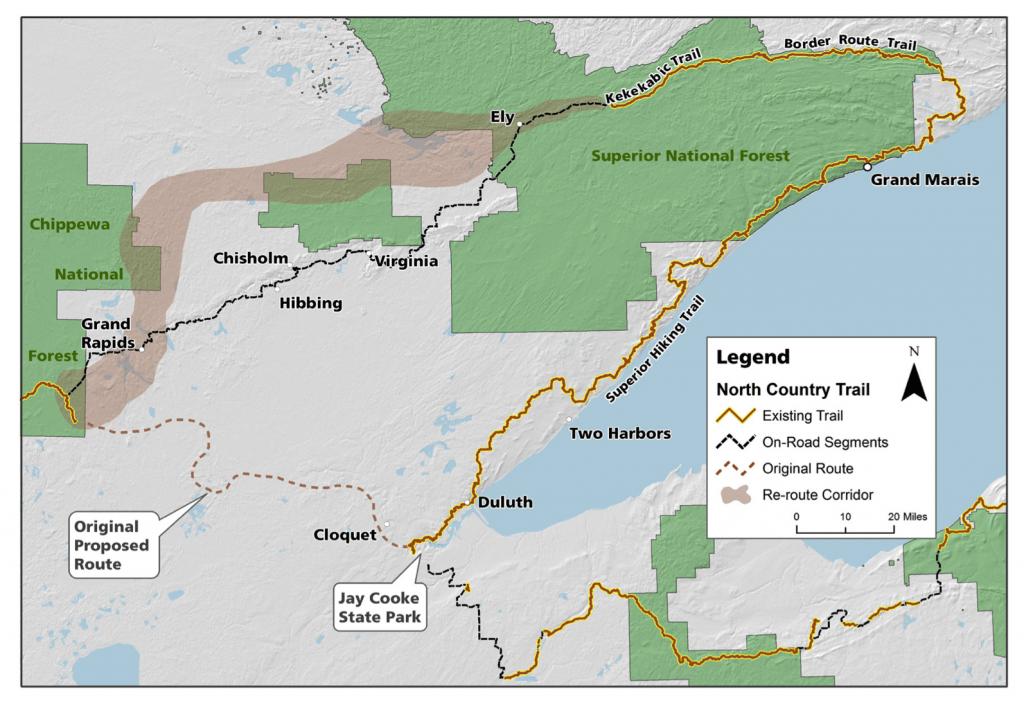
For the past 30 years, hikers have been trying to add existing walking trails in northern Minnesota to the North Country National Scenic Trail, which extends from New York to North Dakota. A recent Congressional hearing served as another leg in the long journey, with Representatives objecting to the plan due to beliefs about energy development and property rights.
When the North Country Trail was designated by Congress in 1980, it was routed straight across 90 miles of swamps between Duluth and Grand Rapids. It quickly became obvious that the route wouldn’t work without expensive boardwalks, and none of it has yet been built. It also became obvious that existing trails were a better option. Seventy percent of the trail needed, about 400 miles, is already laid out in the form of the Superior, Border, and Kekekabic Hiking Trails, passing through some of northern Minnesota’s most scenic country, and maintained by active volunteer groups.
“The coolest thing about our trail is that we aren’t looking for the shortest route,” Matt Davis, NCTA regional trail coordinator for North Dakota and Minnesota, told the Lake County News Chronicle. “Our trail is supposed to be about finding the best as far as scenery, cultural resources, historical features and natural features. We’re not going to do the easiest route, we’re going to do the best route.”
But because the swamp route was described in law, it will take a vote in Congress to change the plan. Hiking groups have been asking for the re-route since 1987, the year after the Superior Hiking Trail was created. The U.S. Senate passed companion legislation this fall.
Last week in Washington, D.C., legislation authored by Minnesota Congressman Rick Nolan to change the route was discussed by the House Natural Resource Committee’s Subcommittee on Federal Lands.
“[The trail is] a part of the exercise, it’s a part the economics of our country and just offers a wonderful opportunity for people to get out and enjoy the great outdoors,” Nolan said in his testimony.
Starting out the hearing, Chairman Tom McClintock of California laid out his opposition, stating that he is concerned about the federal government acquiring additional land, and the possibility that the trail would be used to block other uses.
“We’ve found that many trail groups that advocate for trail expansion then also oppose much-needed energy projects, transmission line corridors, and communications infrastructure that may arise from re-routing and extending trails like this,” McClintock said.
Stephanie S. Toothman, Associate Director of the Park Service, spoke on behalf of the re-route. She explained it was based on a National Park Service study that concluded in 2004 with public meetings in Duluth, Ely, Grand Rapids, and Minneapolis. Widespread public support was received throughout the process.
McClintock sought assurances from the National Park Service representative that state or local governments could not use eminent domain to take private property and then donate it to the federal government for the trail. The National Park Service is prohibited from such actions itself.
Toothman replied that the project had many other options for routing the trail without using eminent domain.
“We have no intention [of using eminent domain],” she said. “At this point we’re not aware that any local or state eminent domain has been used for any part of the route… [W]e have so many other options to work with the public.”
Toothman also offered assurances the re-route would not cause significant financial costs. By using the existing trails, the only maintenance costs would be about $7,000 per year to connect Ely to the Chippewa National Forest along 173 miles of new trail. It could also provide the opportunity for local trail organizations to get National Park Service support.
The re-route must pass before Congress adjourns on Dec. 16 or be re-introduced after it returns in January, starting the process from scratch. Trail advocates hope that the re-route might make it into an omnibus bill, helping it get passed along with other legislation.
“We’re also asking our members in the 7th Congressional District to contact Rep. Collin Peterson to ask that he continue to champion the North Country National Scenic Trail Route Adjustment language,” the North Country Trail Association stated. “Specifically, we are looking for inclusion of the language in the final product coming out of the Energy Policy and Modernization Act’s Conference Committee on which he serves.”
The re-route legislation is designated H.R. 799. It can be tracked at this link. More information about the Arrowhead Re-Route is available on the NCTA website. More information about the trail can be found on the National Park Service website.

